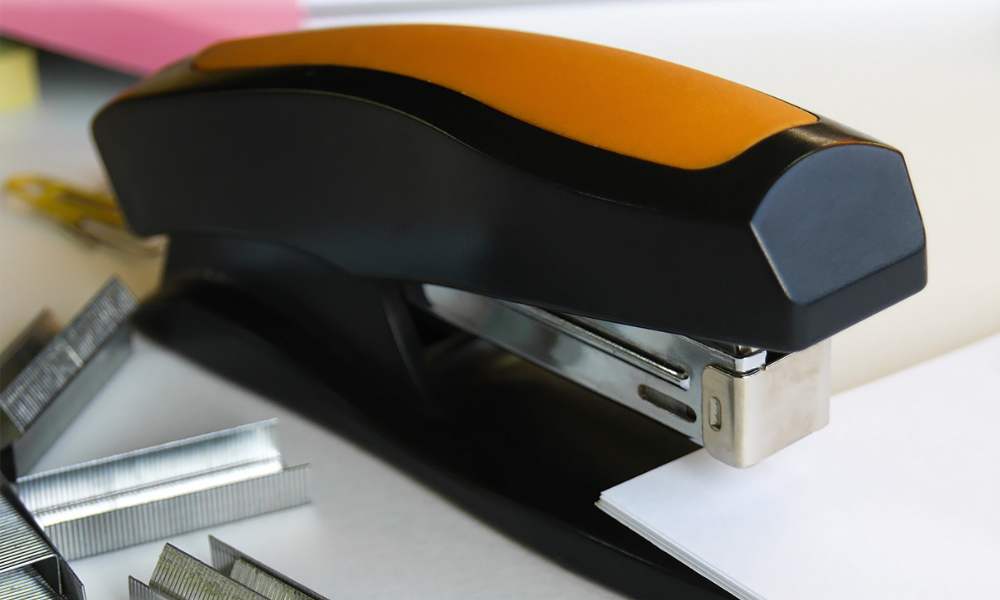A stapler is an essential tool in offices, schools, and homes. Despite its simplicity, improper handling or neglect can lead to frequent jams, misfires, or complete breakdowns. To extend the life of your stapler and ensure smooth performance, follow these essential maintenance tips.
Choose the Right Staples

One of the most common reasons staplers malfunction is the use of incorrect staples. Using the wrong size or low-quality staples can lead to frequent jams and misalignment. Here’s what you need to do:
-
Check the Stapler Manual – Different stapling machines require different staple sizes. Check your stapler’s manual or look for specifications on the device itself.
-
Use High-Quality Staples – Cheap or rust-prone staples can break or cause jams. Invest in high-quality, rust-resistant staples.
-
Avoid Overloading – Inserting too many staples into the tray can cause unnecessary pressure, leading to misfires.
Keep It Clean
Dust, dirt, and old staples can accumulate inside your stapler over time, causing it to jam. Regular cleaning can prevent this:
-
Remove Staples Periodically – Clear out unused staples to check for debris inside.
-
Use a Small Brush – A small paintbrush or an old toothbrush can help remove dust and small particles.
-
Compressed Air – For deeper cleaning, use a can of compressed air to blow out dust from hard-to-reach areas.
-
Wipe with a Cloth – Use a slightly damp cloth to wipe the outer surface and prevent grime buildup.
Lubricate Moving Parts
Lubrication is essential for keeping the stapling machines moving parts in good working condition. Dry, unlubricated parts can lead to stiffness and reduced performance.
-
Use a Light Machine Oil – Apply a drop of sewing machine oil or any lightweight oil to the hinge and spring mechanism.
-
Avoid Over-Oiling – Too much oil can attract dust and dirt, leading to clogging.
-
Wipe Excess Oil – After applying oil, use a clean cloth to wipe off any excess to prevent mess.
Store Your Stapler Properly

Where and how you store your stapling machine also affects its longevity. Poor storage can expose it to moisture, dust, or accidental falls.
-
Keep It Dry – Store your stapling machine in a dry place to prevent rusting.
-
Avoid Direct Sunlight – Prolonged exposure to sunlight can weaken plastic components and cause warping.
-
Use a Drawer or Holder – Keeping the stapling machine in a drawer or designated holder prevents unnecessary falls and damage.
Handle with Care
Many people handle staplers roughly, leading to unnecessary wear and tear. Gentle usage extends its life significantly.
-
Press Firmly, Not Forcefully – Using excessive force can break internal mechanisms. Instead, apply steady and even pressure.
-
Don’t Drop It – Repeated dropping can misalign internal parts and cause jamming.
-
Use the Correct Surface – Always use a flat, stable surface for stapling to avoid undue pressure on the stapler’s base.
Fix Jams Properly
Stapling machines jam occasionally, but how you fix them determines their lifespan. Incorrect jam removal can bend or damage internal parts.
-
Open the Stapler Carefully – Don’t force it open; follow the correct method as per the manufacturer’s instructions.
-
Remove Jammed Staples with Tweezers – Gently pull out stuck staples instead of using excessive force.
-
Check for Bent Parts – If parts are misaligned, carefully realign them using a small tool like pliers.
Know When to Replace Parts
Some staplers come with replaceable parts, such as springs or anvil plates. Replacing worn-out parts can save you from buying a new stapling machine.
-
Check for Worn Springs – If the spring loses tension, replace it instead of discarding the whole stapling machine.
-
Inspect the Anvil Plate – If the staple bends incorrectly, the anvil plate might be damaged and need replacement.
-
Look for Manufacturer’s Replacement Parts – Some high-end staplers have spare parts available from the manufacturer.
Choose a Durable Stapler
If you’re buying a new stapling machine, invest in a durable model that lasts longer with proper care.
-
Go for Metal Over Plastic – Metal stapling machines tend to be more durable than plastic ones.
-
Check Reviews and Ratings – Look for user reviews to ensure the stapler is reliable.
-
Consider Heavy-Duty Staplers for Frequent Use – If you staple often, a heavy-duty stapler will handle the workload better than a standard one.
Use Alternative Stapling Techniques
Certain techniques can reduce wear and tear on your stapler while improving efficiency.
-
Rotate the Anvil – If your stapling machine has a rotating anvil, use it to change the staple’s bending direction for better fastening.
-
Staple Fewer Pages at a Time – Instead of forcing thick stacks, staple in smaller sections.
-
Use a Stapler with an Adjustable Pressure Mechanism – Some stapling machines allow you to adjust the pressure for different paper thicknesses.
Know When to Replace Your Stapler
Even with the best care, they have a lifespan. If yours frequently misfires, jams, or has loose parts, it might be time for a new one.
-
Frequent Jams Despite Cleaning – If jamming continues despite maintenance, internal parts might be too worn.
-
Loose or Broken Components – If parts become loose or break, repairs may not be cost-effective.
-
Staples No Longer Align Properly – If staples misfire or don’t go through paper cleanly, the internal alignment may be permanently damaged.
Final Thoughts
A well-maintained stapling machine can serve you efficiently for years. By following these simple maintenance tips using the right staples, keeping it clean, lubricating parts, and handling it with care you can significantly extend the life of your stapler. Regular upkeep not only saves money on replacements but also ensures a smooth, hassle-free stapling experience. Take a few minutes to care for your stapling machine today, and it will continue to work reliably for years to come!

